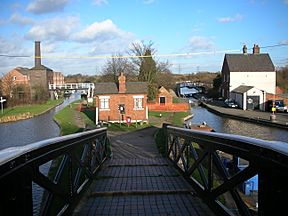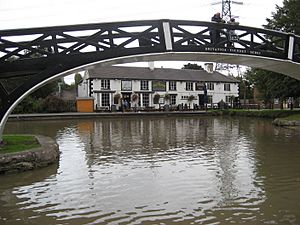Hawkesbury Junction facts for kids
Quick facts for kids Hawkesbury Junction |
|
|---|---|

The engine house and Coventry Canal on the left, with the Oxford Canal on the right
|
|
| Specifications | |
| Status | Open |
| Navigation authority | Canal and River Trust |
| History | |
| Date completed | 1803 |
Hawkesbury Junction, also known as Sutton Stop, is a special place where two canals meet in England. It's where the Oxford Canal connects with the Coventry Canal. You can find it near Hawkesbury Village in Warwickshire, between the towns of Bedworth and Coventry.
The name "Sutton Stop" comes from a family called Sutton. They were lock keepers at this junction for many years in the 1800s.
Contents
History of the Canals
The Coventry Canal was given permission to be built in 1768. Its main goal was to connect Coventry to another big canal called the Grand Trunk Canal (now the Trent and Mersey Canal). But first, it needed to reach the coal mines at Bedworth. This way, coal could be easily moved to Coventry.
The first 10 miles (16 km) of the Coventry Canal were finished in 1769. Moving coal on the canal quickly became very profitable.
The Oxford Canal also got permission to be built in 1769. It was designed by a famous engineer named James Brindley. He built it as a contour canal. This means it followed the natural curves of the land. While this was easier to build, it made the canal quite winding and slow for boats.
Brindley passed away in 1772. Another engineer, Samuel Simcock, finished the Oxford Canal line from Coventry to Banbury by 1778.
The Tricky Junction Agreement
The place where the two canals met caused a lot of arguments. The Oxford Canal's building rules said that both companies had rights to collect money (tolls) from boats using parts of the other canal.
For example, the Coventry company would get tolls for coal boats using the first 2 miles (3.2 km) of the Oxford Canal. And the Oxford company would get tolls for other goods using the first 3.5 miles (5.6 km) of the Coventry Canal.
Originally, the junction was planned for a place called Gosford Green. But James Brindley changed his mind. He wanted to move the junction to Bedworth. This would have meant the Coventry Canal lost money from coal boats. So, they found a compromise.
The junction was built at Longford. The special toll rules were added to make sure the Coventry Canal still earned money. This solution was very complicated. It even made the two canals run side-by-side for a while.
Attempts to Change the Junction
The Oxford Canal company tried many ways to change this complicated agreement. They offered money to the Coventry Canal, hoping to avoid the special toll rules. They even tried to get a new law passed to remove the rules, but the Coventry Canal company stopped them.
Next, they thought about building a bypass canal. This would connect to the Birmingham Canal Navigations and avoid the junction completely. But this plan also failed.
After two years of doing nothing, they tried to reach an agreement again in 1776. They said they would accept the toll payments if the Coventry Canal finished its line to Fradley Junction within five years. The Coventry company replied that if the junction opened right away, they would build their line to Fradley as soon as possible.
The Junction Opens
Finally, the Coventry Canal company took legal action. A court ordered the Oxford Canal company to open the junction. So, the junction officially opened on April 15, 1777, at Longford.
However, there was a problem with the water levels. The Oxford Canal was about 7 inches (18 cm) higher than the Coventry Canal. This meant that every time a boat went through the stop lock, the Oxford Canal lost water to the Coventry Canal.
The canals ran parallel for about 1 mile (1.6 km). This wasted time for boaters and cost money for the companies. One person described the whole setup as "a very troublesome contrivance."
The junction was later moved to its current, better location in 1803. In the past, when canals were busy with trade, this junction was a major meeting spot. Working boats would wait here for their next orders, often to pick up coal from the many mines nearby.
The Engine House and Lady Godiva
A special lock called a stop lock on the Oxford Canal keeps the water levels of the two canals separate. The Oxford Canal's water is still a little higher.
On the western side of the Coventry Canal, there's an old engine house. It was built in 1821. Inside, it used to have a Newcomen steam engine. This engine was very old, having worked for 100 years at Griff Colliery before coming here. It was used to pump water from the mines into the canal to keep it supplied.
The engine was named Lady Godiva. It stopped working in 1913 because the mine shafts had gone too deep for it to pump water effectively. It was left in place for many years. In the 1960s, it was moved to the Dartmouth Museum and is now known as the Newcomen Memorial Engine. The canal was also a good place for the colliery to get rid of the water they pumped out of the mines.
Location and Connections
From Hawkesbury Junction, the Coventry Canal goes southwest to Coventry Basin. This part of the canal is flat and is about 5.5 miles (8.9 km) long.
To the north, the Coventry Canal connects to the Ashby Canal at Marston Junction, which is 2.8 miles (4.5 km) away. This section is also flat until you reach the first lock of the Atherstone flight, about 11.1 miles (17.9 km) from the junction.
The Oxford Canal between Hawkesbury Junction and Braunston (where it meets the Grand Union Canal) was greatly changed in the 1830s. The winding curves that Brindley designed were replaced with straighter sections. This meant building embankments, cuttings, and aqueducts. But it made the journey much shorter, reducing the distance from 36 miles (58 km) to 22 miles (35 km).
The Oxford Canal is flat from the stop lock to Hillmorton Locks, which are 15.3 miles (24.6 km) away. At Hillmorton, there are three pairs of locks. Each lock was duplicated (meaning there are two side-by-side) when the canal was straightened. This was done to handle the large number of boats using the canal.



